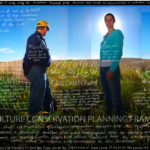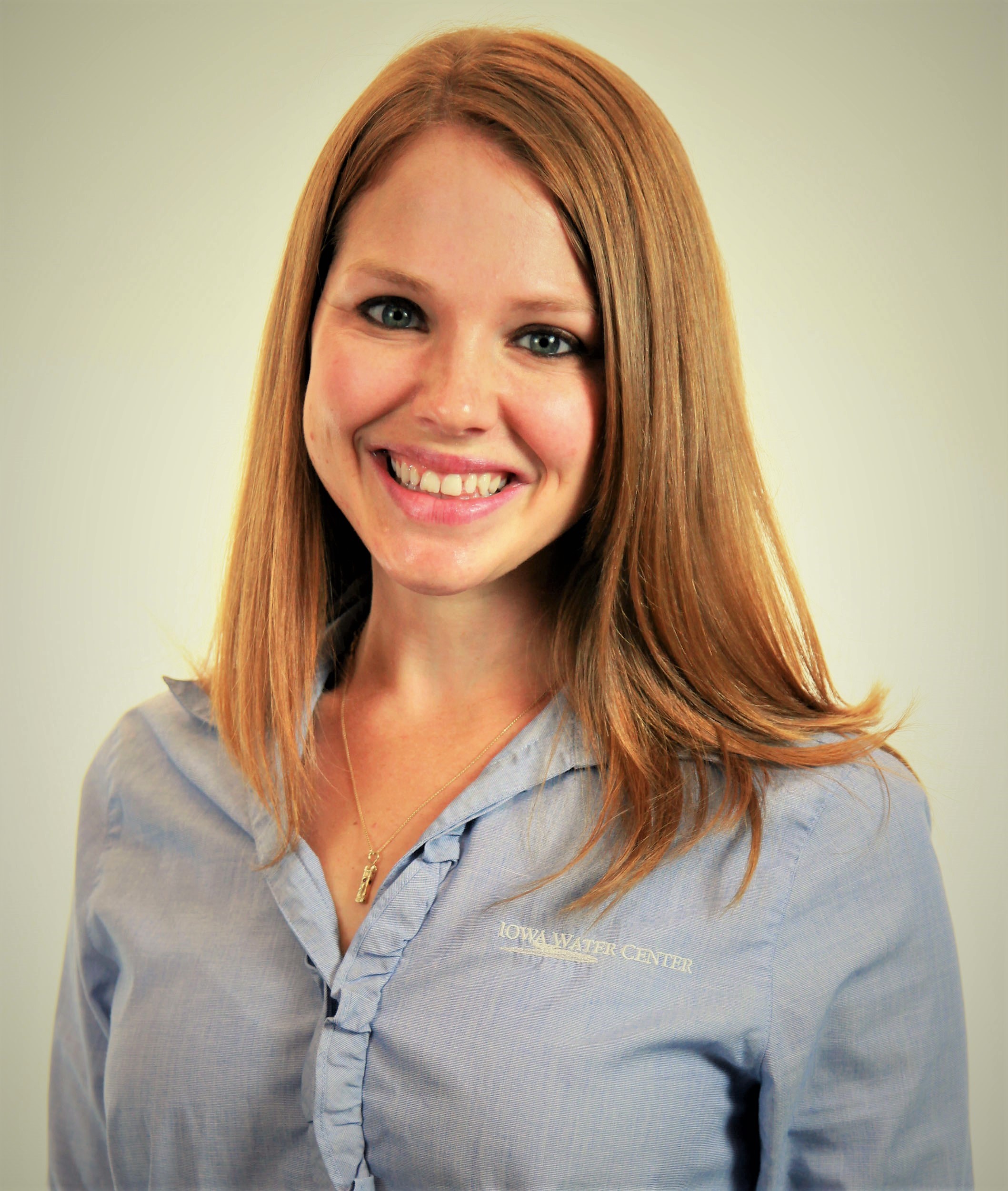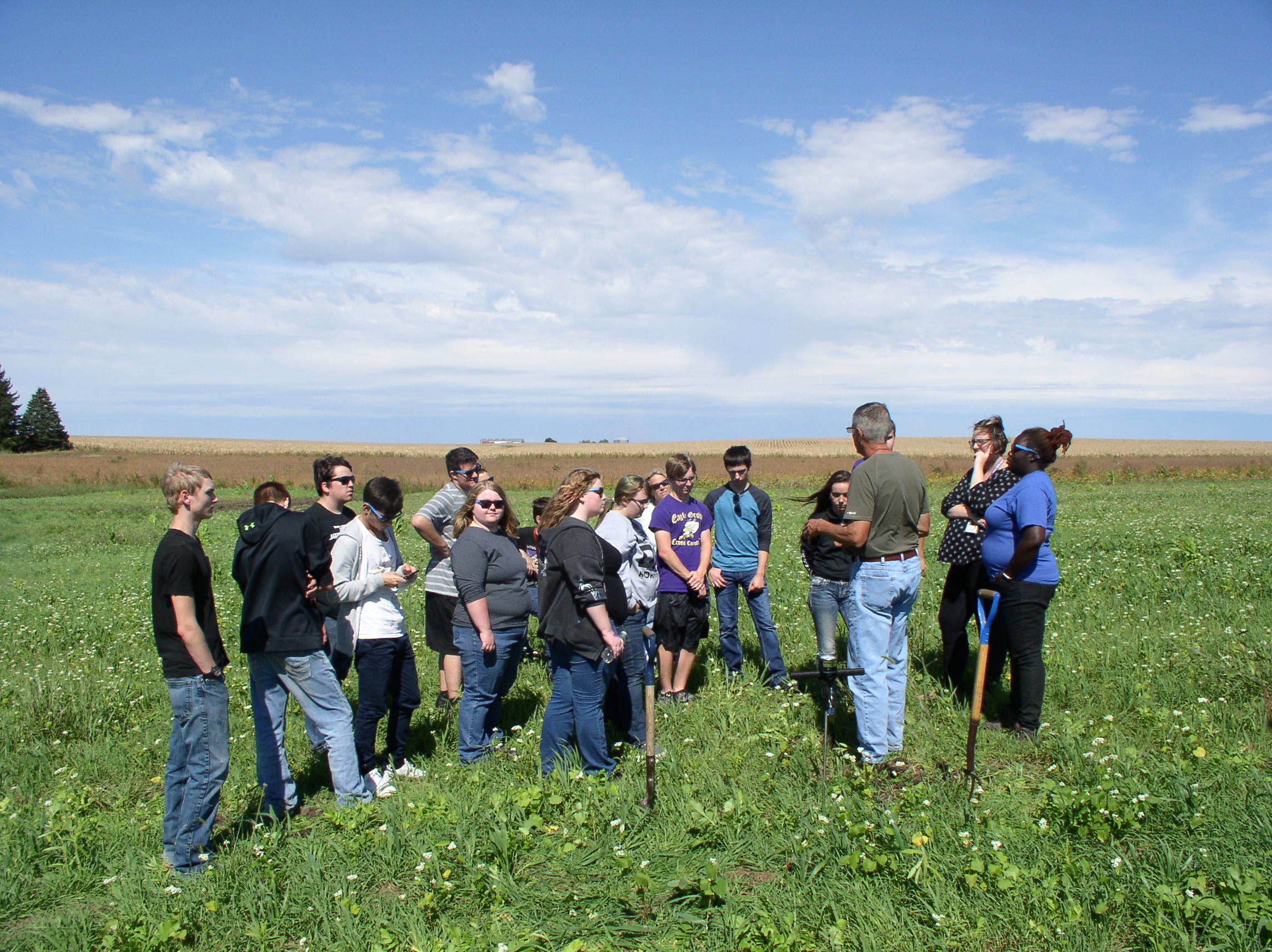In the webinar, “Monarch Butterfly Biology, Ecology and Conservation Needs,” Fisher will highlight the outcomes of collaborative work on monarch butterfly conservation conducted at Iowa State University, including the notable suggestion that milkweed and nectar resources be planted within 50 meters of established habitat to create a functionally connected landscape that facilitates monarch movement.
Continue readingProject-Based Learning for future water leaders
Student project from the Bluestem Institute (left). Image of the Southfork Watershed Alliance sign (right).
Story submitted by Melissa Miller, Associate Director for the Iowa Water Center
In fall of 2015, I met with a group of 60 high school students at the headwaters of the South Fork of the Iowa River, right off the shoulder of Hwy 69 in North Central Iowa. It was a beautiful (but cold) fall morning, and I wasn’t sure what to expect. All I knew was that a class from Ames High School (AHS) was out to define a list of water quality terms, and they were doing so through experiences, including this on-site interview with my local farmer-led grassroots watershed group.
What I found out about this group of students was worth my shivering out in the cold while corn-loaded semis blasted by the school buses at 60 mph. These students and three teachers were part of the Bluestem Institute, an integrated capstone seminar based on project-based learning and extended inquiry frameworks. As I built a relationship over the next several months with teachers Mike Todd, Joe Brekke, and Chad Zmolek, we discovered more ways for the class and the Iowa Water Center to interact, culminating in a gallery showing of the students’ final projects at the 10th annual Iowa Water Conference.
I wasn’t the only one transfixed with the students’ high level of engagement and understanding of complex water issues. Pat Sauer, with the Iowa Stormwater Education Partnership, came to me in early summer of 2016 with a vision of packaging the Bluestem Institute and making it accessible for all schools in Iowa to implement.
Serendipitously, the Leopold Center for Sustainable Agriculture had recently received a bequest from the estate of Iowan Robert Margroff designated for youth education about the environment. With the help of the AHS teachers that created the Bluestem Institute, we submitted and were subsequently awarded three years of funding to develop the framework and pilot it in two Iowa schools.
Now nearly a year into the project, dubbed “The Watershed Project,” we have discovered that we are always learning. Davenport North High School faculty Laura McCreery and City of Davenport Public Works employee Robbin Dunn are nine weeks into implementing the project in McCreery’s classroom. Over the life of the project, we will blog about the process of designing the framework and the experiences of our implementation schools.
The immediate outcome of this project will be an educational framework for teachers to implement project-based learning in Iowa high schools that address intersections of science, government, sociology, economics, and art as they relate to decision-making regarding water and land use at local levels. We hope to inspire more than that – we hope this program inspires students and communities to take greater interest in environmental sustainability issues. We hope the students in these programs consider entering STEM fields post-graduation, armed with interdisciplinary knowledge so they can inspire new solutions. We hope to develop emerging generations of citizens and civic leaders that value and implement environmentally sustainable policies and strategies. Ultimately, we dream of engaged, resilient communities that proactively and collaboratively address soil and water conservation issues.
Melissa Miller is the associate director of the Iowa Water Center. She earned a BS in Kinesiology from Iowa State University with an emphasis in Community and Public Health. She is currently pursuing a MS degree in Community Development with an emphasis in Natural Resource Management, also from Iowa State University.
Eagle Grove Students Learn about Conservation Practices on the Farm
Eagle Grove, IA – On September 20th, the Earth Science class from the Eagle Grove High School took a field trip to a farm operated by Tim Smith. Smith, a White House Champion of Change for Sustainable and Climate-Smart Agriculture, showed how he incorporates cover crops, strip tillage, and a bioreactor into his farm operation. Students also traveled 12 miles north of his farm to tour a wetland CREP site. Tim, along with Bruce Voigts and Tas Stephen from the Natural Resources Conservation Service (NRCS) in the Clarion USDA office, discussed how the benefits these practices add to soil health and water quality.
Continue readingThe Third [Business] Day of Christmas: Breakouts: Strategies for Social Engagement
On the third [business] day of Christmas, the Iowa Water Center gave to me…descriptions for the breakout session Strategies for Social Engagement.
The following presentations will take place at the Iowa Water Conference in Ames on the afternoon of Wednesday, March 23, 2016. Registration for the conference will open in January.
1000s of Acres: Adding Conservation Partners
Angie Carter, Department of Sociology, Anthropology, and Social Welfare at Augustana College in Rock Island, IL & Jean Eells, E Resources Group
Women farmland owners are an important part of watershed level conservation changes in Iowa. Learn from researchers and landowners about how PhotoVoice, a participatory research method, is being used in the Raccoon River watershed to engage this important demographic.
Water in Iowa: Voicing the Lexicon
Chad Žmolek, Mike Todd, Joe Brekke and Ames High School Bluestem Institute students
Students from the Bluestem Institute at Ames High School share insights gained from their journey across Iowa examining water quality issues in collaboration with Project Localize, an educational program that helps classrooms identify and promote sustainable economic, cultural and social progress in their communities. As part of the project, students created unique posters shining light on terms related to water quality. Following the presentation, the students will be available during the conference break to answer questions about their posters, which will be on display in the second floor lobby area.
Iowa farmers’ perspectives on actions toward nutrient reduction strategy goals
J. Gordon Arbuckle, Jr., Associate Professor/Extension Sociologist, Department of Sociology, Iowa State University
In spring 2014, 1,128 Iowa farmers were surveyed to measure their knowledge of the strategy, their attitudes and concerns toward it and its goals, and, importantly, their willingness to take action to help meet those goals. A regression analysis was conducted to evaluate factors that influence farmers’ willingness to take steps to support the strategy. The results of this analysis will be shared.
retaiN Iowa: Engaging Farmers in On-farm Nitrogen Testing
Jamie Benning, Water Quality Program Manager, Iowa State University Extension and Outreach & Clare Lindahl, Executive Director, Conservation Districts of Iowa
retaiN seeks to give farmers the tools and information they need to make the best conservation decisions on their land, starting by helping farmers test for, understand and take steps to retain their nitrogen. The retaiN project developed nitrate testing kits that facilitate farmer engagement in collecting on-farm nitrate concentration data. The retaiN kits were initially distributed in the summer and fall of 2015 through existing watershed projects and ISU Extension field specialists. retaiN is a collaboration between Conservation Districts of Iowa and Iowa State University Extension and Outreach and Iowa Learning Farms with support from the Iowa Department of Agriculture and Land Stewardship, Division of Soil Conservation and Water Quality.
Iowa Water Center seeks partners for community arts event
We’ve got something brewing over here at the Iowa Water Center, and we’re pretty excited about it.
This year is the tenth anniversary of the Iowa Water Conference (in its current form), so we thought we’d make it kind of special. The conference agenda (which will be released soon!) is particularly spectacular this year, but we can always do more.
The idea started off that we’d have Luther professors Jodi Enos-Berlage and Jane Hawley bring their Body of Water performance to Ames for conference goers to attend on the first night of the conference. This multimedia approach to water education seemed like a provocative addition to our two-day event, and we’ve had requests for several years to bring back an evening reception/activity for those attending from out of town. A lovely idea!
But then, we learned about a project that local Ames High School students are working on that also combines art and water education. The students within The Bluestem Institute at AHS are creating photo collages combined with text from interviews to define water quality terms from a technical, social and cultural perspective. They’ll be presenting during the Iowa Water Conference, but the work they’re doing is something to behold, so we didn’t want to limit it to conference attendees.
LIGHTBULB. Gallery session before the Body of Water performance. A community event, adjacent to the Iowa Water Conference, but not solely for paid attendees. Invite the community, far and wide. These unique approaches to water outreach and education need to reach as many people as possible. Our state has some incredibly innovative environmental education efforts (Water Rocks!, anyone?), and it’s our job to display, disseminate, expose and otherwise facilitate learning. We at the Iowa Water Center are on a mission to better the state of water in the state of Iowa. Education and outreach are a big part of that.
But, we can’t do it alone. We want this evening event to be well-attended and free of charge to patrons. So we’re asking for partners – be it financial sponsors, connectors, marketers – whatever you can do to help make this happen, we want to talk to you. If you are interested in learning more or helping us brainstorm, contact us. We can’t wait to talk with you!
Iowa’s Soil and Water Conservation Districts – Good conference, good people
On Tuesday and Wednesday of this week, we headed down to Prairie Meadows in Altoona for the 2015 Iowa Soil and Water Conservation District Commissioners 69th Annual Conference. The Iowa Water Center has exhibited at the last three conferences, and we must say, it gets better every year. Clare Lindahl and her staff at Conservation Districts of Iowa work incredibly hard to put together a fun, informative conference with some big names in the business – the luncheon speaker on Tuesday was Kirk Hanlin, Assistant Chief of the Natural Resources Conservation Service, and on Wednesday, Iowa’s own Secretary of Agriculture Bill Northey.
Our limited budget doesn’t allow us to exhibit at a lot of conferences each year, but we make sure to include this conference at the top of our list. We always see good friends, like Jamie Benning, who masterfully connects people and watersheds to Extension programming as the Water Quality Program Manager for Iowa State University Extension and Outreach, and Jackie Comito with Iowa Learning Farms and Water Rocks! (who, by the way, was honored this past spring as a recipient of the National Wetlands Award). We were happy to see we were positioned next to our perennial neighbor at this conference, Leopold Center for Sustainable Agriculture. It gives us a chance to catch up with our colleagues – these are busy times in the Iowa water landscape, so we don’t always have the time to keep up with each other like we’d like to!
Another reason we keep coming back is the quality conversations we have with attendees of the conference. Our booth is boring compared to some others – we don’t hand out pens, or candy, or keychains – in fact, this year, we just had our display, Iowa Water Conference Save-the-Date postcards, and copies of our white paper of Water Resources Priorities from the 2015 Iowa Water Conference session. But the district commissioners don’t care that they won’t pick up a water bottle or a stress ball from us. They want to know who we are, what we do, what we’re working on, and how they can use us as a resource. These are elected officials who will go back home after two days of soaking up information and will use it to better soil and water conservation management in their district. There are 500 soil and water conservation district commissioners, and they want to talk to you (yes, you!) about what can be done in YOUR district for soil and water. Find contact information for your commissioners and have a conversation about conservation.
RESOURCES: Advanced Technology Environmental and Energy Center
Guest blog written by Heather Ballou, ATEEC Interactive Learning Lab Education Coordinator
The Advanced Technology Environmental and Energy Center (ATEEC) first opened their doors in 1994 as a National Science Foundation’s Center of Excellence. For the last twenty years, ATEEC has been providing high-quality publications focusing on different conservation employment categories, compiling and vetting curriculum for all schooling levels, and facilitating expert panels. The newest publications released by ATEEC are Defining Water Management and Regional Water Conversations. ATEEC facilitated a series of six regional water forums. The conversations allowed ATEEC to obtain a snapshot view, from water experts across the country, of new and existing water management jobs and determine regional employment opportunities. This information is compiled into a series of reports and charts. To see the water management reports and others, please visit ateec.org.
ATEEC is also home to the Interactive Learning Lab. The Lab is a great location for middle school and high school students to visit and learn more about green topics. A hands-on permanent display allows visitors to explore the topics of energy and green homes, along with wind, solar, geothermal, and biofuel energy sources. Visitors include field trip groups from all school districts in the Quad City area, after-school programs, and other specialty groups.
The Interactive Learning Lab also is a source of curriculum and activities for local educators. Through our Carver Lending Library, we are able to provide unique learning experiences for students in their own classrooms. Workshops are held throughout the year to introduce teachers to different green topics and familiarize them with the items available through the Carver Lending Library.
The permanent display at the Lab focuses on water conservation. For many students, this is the first time they have seen a rain barrel and offers a great opportunity to discuss landscape water use. The water conservation activity encourages students to predict what simple household changes translate into the largest amount of water saved. The students leave the station with simple ideas they can do to influence their family’s water use.
A few weeks ago, the ATEEC Interactive Learning Lab was able to assist 25 regional boy scouts working on their Sustainability Merit Badge. During this half-day intensive workshop, the boy scouts looked at water conservation. They performed an experiment to determine how much water is wasted by a leaky faucet in one year. The amount of water was staggering. The scouts discussed ways they can conserve water in their homes. Shorter showers, turning off faucets when not in use, and fixing any leaks were just a few of their solutions.







